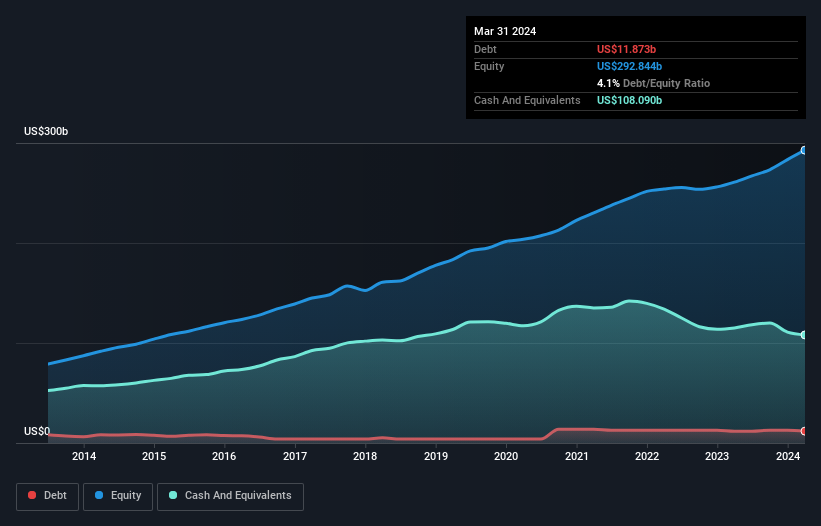Is Alphabet (NASDAQ:GOOGL) A Risky Investment?
Some say volatility, rather than debt, is the best way to think about risk as an investor, but Warren Buffett famously said that 'Volatility is far from synonymous with risk.' When we think about how risky a company is, we always like to look at its use of debt, since debt overload can lead to ruin. We can see that Alphabet Inc. (NASDAQ:GOOGL) does use debt in its business. But is this debt a concern to shareholders?
When Is Debt A Problem?
Debt is a tool to help businesses grow, but if a business is incapable of paying off its lenders, then it exists at their mercy. Ultimately, if the company can't fulfill its legal obligations to repay debt, shareholders could walk away with nothing. However, a more common (but still painful) scenario is that it has to raise new equity capital at a low price, thus permanently diluting shareholders. Having said that, the most common situation is where a company manages its debt reasonably well - and to its own advantage. When we think about a company's use of debt, we first look at cash and debt together.
See our latest analysis for Alphabet
What Is Alphabet's Net Debt?
The chart below, which you can click on for greater detail, shows that Alphabet had US$11.9b in debt in March 2024; about the same as the year before. But it also has US$108.1b in cash to offset that, meaning it has US$96.2b net cash.
How Healthy Is Alphabet's Balance Sheet?
We can see from the most recent balance sheet that Alphabet had liabilities of US$77.0b falling due within a year, and liabilities of US$37.5b due beyond that. Offsetting this, it had US$108.1b in cash and US$44.6b in receivables that were due within 12 months. So it can boast US$38.1b more liquid assets than total liabilities.
Having regard to Alphabet's size, it seems that its liquid assets are well balanced with its total liabilities. So it's very unlikely that the US$2.03t company is short on cash, but still worth keeping an eye on the balance sheet. Succinctly put, Alphabet boasts net cash, so it's fair to say it does not have a heavy debt load!
On top of that, Alphabet grew its EBIT by 34% over the last twelve months, and that growth will make it easier to handle its debt. The balance sheet is clearly the area to focus on when you are analysing debt. But ultimately the future profitability of the business will decide if Alphabet can strengthen its balance sheet over time. So if you're focused on the future you can check out this free report showing analyst profit forecasts.
Finally, a company can only pay off debt with cold hard cash, not accounting profits. While Alphabet has net cash on its balance sheet, it's still worth taking a look at its ability to convert earnings before interest and tax (EBIT) to free cash flow, to help us understand how quickly it is building (or eroding) that cash balance. Over the most recent three years, Alphabet recorded free cash flow worth 80% of its EBIT, which is around normal, given free cash flow excludes interest and tax. This free cash flow puts the company in a good position to pay down debt, when appropriate.
Summing Up
While we empathize with investors who find debt concerning, you should keep in mind that Alphabet has net cash of US$96.2b, as well as more liquid assets than liabilities. And we liked the look of last year's 34% year-on-year EBIT growth. So is Alphabet's debt a risk? It doesn't seem so to us. Above most other metrics, we think its important to track how fast earnings per share is growing, if at all. If you've also come to that realization, you're in luck, because today you can view this interactive graph of Alphabet's earnings per share history for free.
When all is said and done, sometimes its easier to focus on companies that don't even need debt. Readers can access a list of growth stocks with zero net debt 100% free, right now.
Have feedback on this article? Concerned about the content? Get in touch with us directly. Alternatively, email editorial-team (at) simplywallst.com.
This article by Simply Wall St is general in nature. We provide commentary based on historical data and analyst forecasts only using an unbiased methodology and our articles are not intended to be financial advice. It does not constitute a recommendation to buy or sell any stock, and does not take account of your objectives, or your financial situation. We aim to bring you long-term focused analysis driven by fundamental data. Note that our analysis may not factor in the latest price-sensitive company announcements or qualitative material. Simply Wall St has no position in any stocks mentioned.

 Yahoo Finance
Yahoo Finance 
